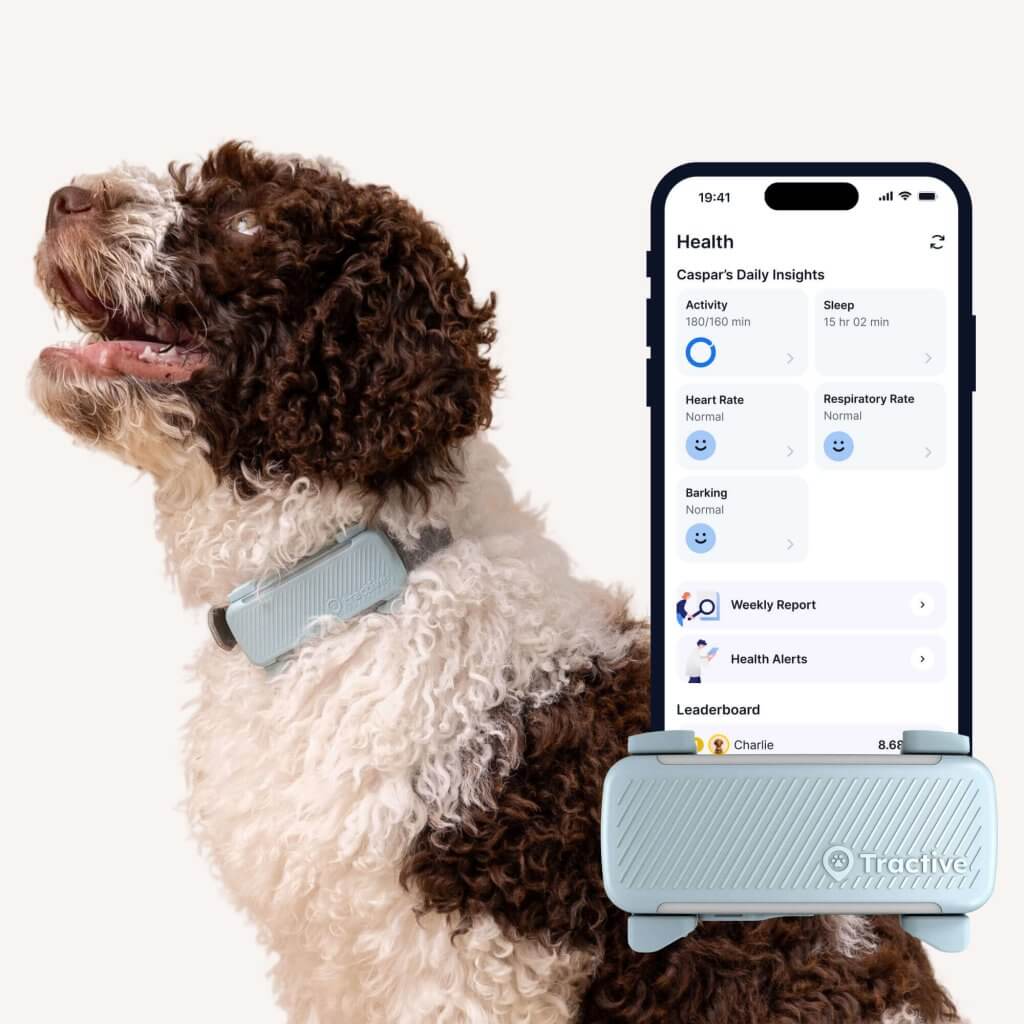 Approved by Dr. Dwight Alleyne, DVM
Approved by Dr. Dwight Alleyne, DVM Top Reasons For A Dog Not Eating (& What You Can Do About It)
It can be scary when your dog won't eat, or when your good boy or good girl's just not acting like themselves. Discover the common reasons for a dog not eating below plus tips to get them eating again.

If your dog is suddenly turning their nose up at dinner, it’s natural to worry. Is it just a picky mood – or something more serious? Whether you’re dealing with a dog who’s skipping meals or completely refusing to eat, we’ve got you covered. Below, we’ll walk you through the most likely reasons for a dog not eating, what you can do to help, and when it’s time to call the vet.
Key Takeaways
- Dogs may stop eating due to illness, pain, age, stress, food issues, or environmental changes.
- A dog not eating for more than 24–48 hours is a sign to call your vet.
- A smart dog tracker can help you stay on top of changes in your dog’s activity and health.
- If your dog is sick, early detection and treatment are key to a positive health outcome1.

Always know your buddy is healthy & safe
Read moreTypes of appetite loss in dogs
If your dog’s not eating, they’ve lost their appetite. Here are a few different ways that vets distinguish between different types of appetite loss in dogs:
- Anorexia: In veterinary medicine, anorexia refers to a complete loss of appetite – when your dog refuses food entirely. This is different from the human eating disorder of the same name.
- Pseudo-anorexia: In pseudo-anorexia, your dog wants to eat but can’t due to pain or physical discomfort—often caused by dental disease, a mouth injury, or another underlying issue2.
- Hyporexia: Hyporexia means partial loss of appetite. Your dog might still eat, but less than usual or with less enthusiasm.
- Dysrexia: Dysrexia describes abnormal eating behavior. For example, your dog may ignore their regular food but still accept treats, or eat inconsistently throughout the day3.
Top reasons for a dog not eating
Dogs, like people, can occasionally lose interest in food—and not every skipped meal means something is wrong. But if your furry friend hasn’t eaten in 24-48 hours (or is missing multiple meals), it’s time to figure out why. Here’s a breakdown of the most common reasons.
🩺 Medical reasons for a dog not eating
Many health problems can cause a dog to stop eating. These are some of the most common medical causes of appetite loss in dogs:
- Dental problems – Broken teeth, gum disease, or oral tumors can make chewing painful.
- Digestive issues – Pancreatitis, inflammatory bowel disease, or parasites may cause nausea or bloating.
- Infections or systemic illness – Kidney or liver disease, fever, or cancer can all reduce appetite.
- Medication side effects – Some meds may alter taste or upset the stomach.
- Pain or injury – Whether it’s arthritis or a sore muscle, discomfort may keep your dog from eating.
🚨 If your dog hasn’t eaten for 24–48 hours, or seems weak or unwell, contact your vet right away.

Get health alerts for your dog
Our pups can’t always tell us if something’s wrong. But if their tracker detects unusual changes in their routine, you’ll get an alert, helping you catch potential issues early.
🐾 Behavioral reasons for a dog not eating
Just like us, dogs can be emotional eaters or non-eaters. The following are a few of the possible behavioral reasons for a dog not eating:
- Stress and anxiety – Changes like travel, loud noises, or a new home can throw off their appetite. Separation anxiety in dogs can also be the culprit.
- Picky eating – Some pups develop strong food preferences and wait for their favorite snacks.
- Too many treats – Excessive treats between meals may cause your dog to skip proper food.
What to do: Stay consistent. Create a calm routine and keep treats minimal.
🏠 Environmental reasons for a dog not eating
Sometimes it’s not what’s in the bowl – but everything around it.
- Distractions at mealtime – Loud noises, unfamiliar guests, or other pets can disrupt eating.
- Uncomfortable feeding location – Cramped corners, busy hallways, or noisy kitchens may deter eating.
- Temperature extremes – Dogs may eat less in hot weather or prefer warm food when it’s cold.
- Bowl issues – Some dogs dislike the noise or glare of metal bowls.
Try this: Feed your pup in a quiet, cozy spot using a non-metal bowl.
🍲 Problems with the food
Food can go wrong in more ways than you’d think. Common issues include:
- Spoiled or expired food
- Too abrupt a food switch
- Same food for too long (boredom)
- Unappetizing texture or temperature
- Allergic reactions or sensitivities
Tip: Gradually transition to new food, keep it fresh, and serve at a temperature your dog likes.
🐶 Age-related eating changes
Dogs of different ages have different eating habits and nutritional needs.
- Puppies have fast metabolisms and need to eat frequently – usually 3 to 4 times per day. If your puppy isn’t eating, it could signal teething pain, intestinal worms, or stress from recent changes (like adoption or weaning).
- Older dogs may experience a natural decline in appetite due to:
- Slower metabolism
- Reduced sense of smell and taste
- Chronic conditions like arthritis or dental problems
What to do: Feed age-appropriate food, keep a consistent routine, and monitor them closely. Senior dogs may benefit from softer textures or warmed meals.
How long can a dog go without food?
In general:
- Healthy adult dogs: Can survive 3–5 days without food (but this is not healthy or safe).
- Puppies and seniors: More vulnerable; even 12–24 hours without food is concerning.
- Without water: Dehydration can set in within 24–48 hours, which is more dangerous than lack of food.
If your dog hasn’t eaten for a full day, contact your vet – sooner for vulnerable dogs.
How to encourage your dog to eat
Once medical issues are ruled out, try these tips to get your dog eating again:
- Warm up the food to boost aroma and make it more appealing
- Entice your dog to eat with food toppers (e.g. egg, sardines, bone broth)
- Offer food in a quiet, familiar place
- Switch up the bowl (ceramic often works well)
- Stick to regular mealtimes
- Try going for a walk to stimulate their appetite
- Feed your dog a consistent, balanced and healthy diet
- Remove uneaten food after 15–20 minutes
- Limit treats and table scraps
- Keep your dog’s food and water bowls clean
- Experiment with different types of foods (dry vs wet) to see what your dog likes
- Be patient and supportive, rather than angry, towards your dog when they won’t eat
- Be aware of what foods dogs cannot eat
Special considerations for senior dogs
As your pup ages, they may need special help with meals:
- Use elevated bowls for dogs with arthritis or joint pain.
- Choose soft or moistened food for dental comfort.
- Warm food slightly to bring out flavor.
- Schedule routine vet visits to monitor health and weight changes.
Should you force feed a dog?
No, you should never force feed a dog, unless explicitly advised to by a vet. If your dog refuses to eat, it could indicate a medical issue or discomfort, and it’s important to identify the cause. Forcing food can cause stress and may worsen the situation. If your dog is consistently refusing food, it’s best to consult a veterinarian to determine the underlying problem. Always offer food in a calm, supportive environment, and if necessary, explore alternatives or prescribed solutions under veterinary guidance.
When to seek veterinary help
Contact your vet if:
- Your dog hasn’t eaten for 24–48 hours
- They’re showing other signs of illness in dogs (vomiting, diarrhea, lethargy)
- You notice sudden weight loss or major behavior changes
- Even their favorite treats don’t work
How a smart dog tracker can help
Sometimes, a drop in appetite is part of a larger health issue. Dogs often move less or sleep more when something’s wrong. A Tractive GPS & Health Tracker for dogs helps you stay one step ahead with:
- Daily activity monitoring
- Sleep quality tracking
- Early health alerts if something’s off
Cissy, a dog parent in the Netherlands, recently shared her experience with Tractive’s Activity Monitoring and Health Alert features: “The insights are amazing. Thanks to Tractive, I’ve learned to recognize early warning signs of all sorts of issues. I knew when Evi had a slight limp, when she had a bladder infection, and when Faye had stomach issues – all thanks to the detailed data in the app.”
Read her story here: How Tractive Helped This Dog Parent Catch An Illness Early
Final thoughts
When your dog won’t eat, it’s important to stay calm, observant, and proactive. Appetite loss can be temporary – or it can signal something more serious. Either way, there are clear steps you can take to help your pup feel better fast. And with the right tools you can catch appetite-related issues early and give your dog the care they deserve. 🐶💚
Did you like this blog post? Then subscribe to the Tractive newsletter to get more helpful tips on dog behavior, health, nutrition and more.
Your furry friend’s health and wellbeing means as much as to us as it does to you. So we’ve made it a priority to only share medically-relevant content on our blog. This post was checked, double-checked, and medically verified by Georgia-based vet, Dr. Dwight Alleyne.

Dr. Dwight Alleyne, DVM
Originally from Long Island, New York, Dr. Alleyne began his career at a no-kill animal shelter before becoming a licensed veterinary technician. He graduated from Cornell University Veterinary College in 2006 and completed an internship at Purdue University. Now practicing in Georgia, Dr. Alleyne specializes in soft tissue surgery and ultrasounds. He also writes pet health articles on his website, “The Animal Doctor Blog” (www.anmldrblog.com).




